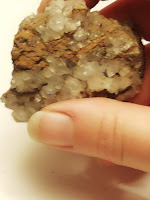 One of my favourite passtimes is to go out into this fabulous wilderness that surrounds me and retrieve mineral samples. This started as a lifelong interest in crystals, their healing power and their downright prettiness and has led me to some astonishing natural landscapes in the short year I have spent on it so far.
One of my favourite passtimes is to go out into this fabulous wilderness that surrounds me and retrieve mineral samples. This started as a lifelong interest in crystals, their healing power and their downright prettiness and has led me to some astonishing natural landscapes in the short year I have spent on it so far.The photograph to the right is actually from a public park as you enter Kilsythe from the east. Dog (Kai) and I climbed to the top of the cliff face to look for rocks. This is the view from the top. There were some beautiful views but no visible quartz veins or other evidence of good veins.
Although this location wasn't successful the areas both north and south of where I live are littered with good finds.
 |
| Glencrieff Mine |
There are three main veins that dissect Scotland and are of geological interest. The first dissects along the Southern Uplands range, the second along the Tyndrum band and the third can be found north again, this time up as far as Helmsdale. Understand that these veins run all the way across the country and are not limited to those areas.
 |
| This Calcite formed on hardened dirt |
This means that all of these areas where gold is found is actually also prime crystal picking territory. The Calcite crystal sample to the right actually came from the mine pictured above. Calcite grows in absolute abundance here. You can't throw a stone without finding that stone is made of Calcite! These crystals are often growing on or around rock and are usually combined with other minerals from the area, such as Pyrite and Galena, which is a deep blue-grey when found in this locale.
 |
| Calcite Crystal from Wanlockhead, Scotland |
The Calcite crystals themselves are mostly white and off-white. Some are yellow and some are stained red while some are growing from Galena leading to a beautiful silver blue hue on the surface crystal.
I learned early on that the make-up of Calcite means it will bubble when you put acid on it. This didn't stop me leaving a few pieces in vinegar to see what would happen. Within moments the vinegar turns black and murky as it starts to dissolve the dirt molecules. Unfortunately it doesn't stop there, and it will move on to destroying any aged calcite crystals that are breaking down already. Ultimately you will be left with only the strongest of the crystals and even these will be coated with a powdery dusting of dissolved calcium.
 |
| Possible Pyromorphite from Wanlockhead, Scotland |
Interestingly, if you put quartz into acid it won't bubble. So if you ever find yourself with an unknown clear crystal formation and you pop it into vinegar the Calcite will produce small bubbles while the quartz will not! Not so common in this area but still found are Pyromorphite and reportedly Flourite, although I have yet to find any. Gold too, of course, though all I ever get in my pan is flour gold too fine to amount to anything.
 | |
| My rock box, where crystals go to be cleaned |
 |
| Kai at Elie Bay |
More recently we took a road trip out to Elie Bay in the hope of finding some of the elusive Elie Bay rubies. No joy yet, but we did come across this magnificent vein in the exposed bedrock. I believe it is quartz but I have yet to test it in acid. The theory of Elie Bay is to do with a deep red coloured seaweed dyes the rock red. I don't know if I have been searching the wrong locations or what but I haven''t given up on finding an Elie Ruby yet...
Lastly for today I think, Scotland is home to some of the most beautiful Morion quartz in the world. Me and doag are always out hunting the darkest pieces and actually sell some of it on Etsy. If you happen to be a crystal collector or someone with a tumbler who wants samples get in touch and we can work something out. In the meantime, enjoy the pictures and I will try to keep you up-to-date with my escapades... it all slows down here in the winter though... but I have a whole summer's worth of rocks to sort out meantime!
 |
| Morion Smokey Quartz from my collection |
No comments:
Post a Comment